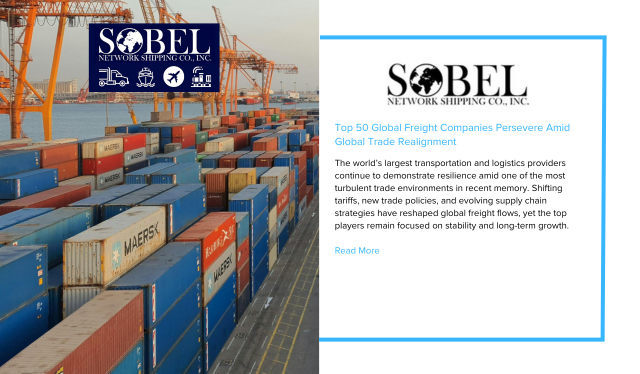The world’s largest transportation and logistics providers continue to demonstrate resilience amid one of the most turbulent trade environments in recent memory. Shifting tariffs, new trade policies, and evolving supply chain strategies have reshaped global freight flows, yet the top players remain focused on stability and long-term growth.
The 2025 Global Freight Top 50 ranking, compiled with data from SJ Consulting Group, highlights the largest freight transportation providers across all modes — including truck, parcel, rail, ocean, air, and third-party logistics (3PL) operations. Rankings are based on 2024 full-year freight revenue, reflecting the sector’s performance before the most recent trade policy changes.
Despite uncertainty, most of the top 50 companies recorded year-over-year growth, underscoring the adaptability of the global logistics industry.
Key Movers and Market Leaders
E-commerce logistics continues to dominate. The world’s leading online retailer retained its top position, reporting over $156 billion in net sales from third-party seller services in 2024 — up from $140 billion the previous year.
Among parcel carriers, UPS surpassed FedEx to claim the No. 2 spot, reporting more than $91 billion in freight revenue, compared with $87 billion for its rival. The U.S. Postal Service held steady at No. 4 with revenue near $79 billion, while Germany-based DHL Group remains the highest-ranked international provider at No. 5.
In ocean shipping, France’s CMA CGM moved ahead of Denmark’s Maersk to become the top global carrier.
A notable newcomer to the Top 50 is Walmart (No. 32), recognized for expanding its in-house freight network and parcel delivery services linked to its marketplace fulfillment operations.
Mergers, Acquisitions, and Market Shifts
Industry consolidation continues to reshape the logistics landscape. A proposed merger between Union Pacific and Norfolk Southern would combine two Class I railroads — Nos. 14 and 26 on the list — into a transcontinental network. Meanwhile, Danish logistics group DSV (No. 15) completed its acquisition of DB Schenker, formerly ranked No. 49, expanding its global forwarding footprint.
North America remains a powerhouse, with 21 of the Top 50 companies based on the continent — 18 in the U.S. and three in Canada. China, Germany, and Japan each host five of the top performers.
Regional Leaders and Performance Highlights
-
C.H. Robinson (No. 21): $16 billion in freight revenue, maintaining its position as one of the largest 3PLs globally.
-
J.B. Hunt Transport Services (No. 27): $12 billion in annual revenue despite a 6% decline.
-
Expeditors International (No. 29): $10.6 billion, up 14% year-over-year.
-
XPO (No. 39): More than $8 billion in LTL revenue growth.
-
Ryder System (No. 40): Recognized for its integrated logistics and dedicated transportation operations.
-
Knight-Swift, TFI International, Landstar, Old Dominion, and Schneider round out the list, representing North America’s robust trucking sector.
Freight Sector Breakdown
This year’s ranking includes:
-
11 parcel delivery providers
-
11 rail carriers
-
10 ocean shipping lines
-
10 3PLs
-
8 trucking companies
The diversity of modes represented highlights the global freight sector’s interdependence — a balance between asset-based carriers and logistics orchestrators that underpin international trade.
Conclusion
Despite economic headwinds, the world’s top logistics companies continue to innovate through scale, technology, and global partnerships. As new trade frameworks and tariffs evolve, these market leaders remain central to maintaining supply chain continuity across continents.


